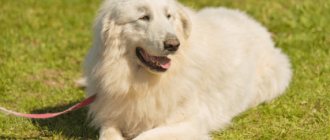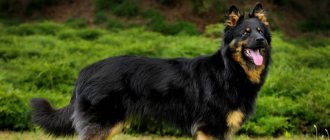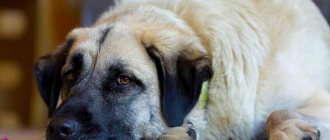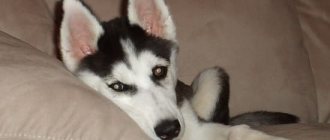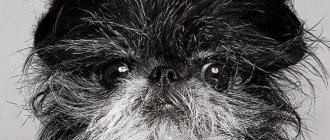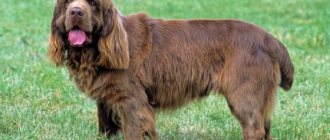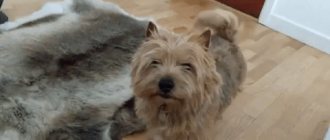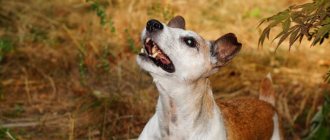History of the origin of the Husky breed: the beginning
In order to begin an excursion into the origin, it is necessary to first determine the source of the name of the breed. By the way, there are several options:
- The history of the origin of the Husky breed originates in the northern lands. And the word “husky” once meant Eskimos. But I don’t advise you to rush to look for the deep subtext of such a name. It's very simple: "husky" is just a corruption of "eskey". I think many have already guessed that “Eski” and “Eskimo” are one and the same. Only the first option is slightly distorted and has, one might say, slang origin.
- The breed is extremely accurately named also because “husky” in English means “husky.” And this is not a coincidence: the fact is that this breed tends to make growling, hoarse sounds.
So where did the story of this “Growling Eskimo” come from? Around 4,000 years ago, people from what is now Central Asia migrated to the northern regions. And not alone, but with smaller brothers.
We can safely say that the origin of the Husky breed is related to wolves, since active crossing with them took place in the North.
This northern dog lived approximately in the northeastern region of Siberia. For several thousand years, the Chukchi associated their life with this wonderful dog. The fact is that “training” and “husky” are easily compatible concepts, so this breed makes an excellent work companion. The Chukchi were not in the habit of leaving written evidence. However, I think the nuances of their way of life many centuries ago are easy to understand for the reason that they have undergone virtually no changes. By the way, I note that the Husky breed has undergone minimal changes since its origin. Largely due to such conservatism of the people.
How did this breed help? The fact is that a strong, hardy, discreet, intelligent, loyal and active dog could cover many kilometers on an ice-covered surface. And at the same time, I note, there is a minimum need for food! Naturally, hunting grounds did not always provide as much food to humans as required. Therefore, it was in the interests of the Chukchi to periodically move in search of it, and then return to their villages. It is not surprising that this breed of dog came in very handy. Also, in cold weather, huskies willingly shared their warmth with the children of their owners, which, I suspect, significantly helped their survival.
Education and training
Huskies have always existed side by side with people and on equal rights, so they will not tolerate disdain and rudeness towards them.
First of all, you need to choose a nickname for your pet. It’s better if it’s short, but sonorous, so the dog will remember it faster.
to raising a husky from puppyhood, clearly defining the boundaries of what is permitted .
It is important to show patience, perseverance and strength of character so that the husky does not have a chance to refuse to follow a command or violate any prohibition.
CAREFULLY!
You cannot beat your pet or humiliate it in any other way - you can achieve obedience from a dog only by building a trusting and respectful relationship with it.
It is necessary to master all the basic commands with a husky - “Fu”, “Come to me”, “Sit”, “Near”, “Place”.
Also, since huskies are sled dogs, you can teach them the commands “Forward”, “Right/Left” and “Stop”, and show dogs will need knowledge of the commands “Give a paw”, “Show your teeth”.
Husky in Alaska
The breed would probably have disappeared that way, but it’s time to shift the chronology of my story to an earlier time. In 1880, gold was discovered in Alaska. I think it’s easy to guess that a huge number of seekers of this wonderful metal immediately rushed there. Not everyone was lucky, as enthusiasts immediately faced the very mundane question of transportation. Particularly savvy seekers realized that they needed to look for suitable dog breeds for sleds. Moreover, those who, due to their origin, are able to cope with transportation in the northern lands.
Such a helper breed was sought out experimentally. And at first, mainly from individuals whose origin was local. There were even sled competitions, whose owners felt real pride.
In 1907, an entire club dedicated to dog breeding was even organized in Nome.
Around this period there was a turn in the history of the Huskies. William Gusak, a fur trader from Russia, brought these dogs from the Siberian lands. Not only a puppy, but also an adult representative of it, as I already said, is quite small. At first, this breed was even called “Siberian mice”.
However, the origin of the dogs quickly made itself known, and they found fans. One of them was Foke Maul Ramsey, an athlete and gold miner. He was so delighted that he even organized an expedition to Siberia in order to get these wonderful dogs. At the same time, interest in harness racing increased. Lighter harnesses and sleds were specially designed - just what a husky needs!
Short description
Huskies medium-sized dogs with a harmoniously built body with developed muscles, a wide and deep chest, a straight back and a rounded head proportional to the body .
They have slightly slanted, almond-shaped eyes that can be light blue, blue, gray or brown, and heterochromia is common.
The ears are medium-sized, triangular in shape, with slightly rounded tips. The nose can be black, brown or gray - pigmentation depends on the color of the coat.
Double coat, consisting of hard guard hairs and soft, thick and dense undercoat, thanks to which they easily tolerate frosts down to -50-60 ° C.
Types of crossbreeds (mestizos)
Crossbreeding dogs of different breeds in order to obtain new species or improve their qualities is a common practice. Huskies were no exception - quite a few of them were bred as mixed breeds.
With a shepherd
These are large, short-haired dogs with an active and playful character, strength and intelligence . It is impossible to predict the exterior of a crossbreed in advance, but most often they inherit the blue eyes of a husky and the coat color of the “Germans”.
With a golden retriever (Rehasky)
Obedient dogs with a balanced, calm character, whose exterior is dominated by the features of a retriever.
With Akita Inu
Akita Inu genes dominate in appearance, but some facial features may be inherited from the Husky. These are purposeful, independent and sometimes overly stubborn dogs with pronounced nanny instincts.
With Shar Pei
Shar Pei genes predominate in the exterior, but coat color is unpredictable. These are smart, friendly animals that need active, long walks.
With chow chow
The exterior, color and volume of coat of the mestizos are inherited from the Chow Chow, and the height, eye color and contour of the spots on the coat are inherited from the Husky. They are characterized by a friendly disposition and the ability to get along with children.
With a husky
Husky and husky mix is the most successful crossbreed option . Such dogs are natural hunters and watchdogs. They are highly active and somewhat selfish.
With Pomeranian Spitz (Pomsky)
Pomskies are good-natured and sociable dogs . From Huskies they inherit eye color and a tendency to heterochromia, the shape of the tail, erect pointed ears, endurance, stubbornness and willfulness, from Spitz - small stature, intelligence and the ability to learn.
With Welsh Corgi (Horgi)
Externally, mestizos look like mini-huskies; they have short legs and an elongated body. The coat is most often black and white, the eye color is inherited from the husky. These are friendly and playful dogs with highly developed intelligence.
There are known cases of unplanned matings of huskies and mongrels..
Huskies are also often crossed with pugs, Jack Russell terriers, Yorkies, Chihuahuas, malamutes, Rottweilers, Dobermans, Dalmantines, Samoyeds, pit bulls, Alabai, bulldogs, Staffords, Shiba Inus, and beagles.
Basics of care
Huskies are unpretentious dogs that do not require labor-intensive care . To maintain an attractive appearance and health of your pet, you just need to regularly carry out the necessary hygiene procedures.
Wool and bathing
You need to brush your husky's coat 2-3 times a week, and daily during the shedding period. This will help your pet quickly get rid of dead hairs and eliminate the possibility of matting and the formation of tangles.
If the dog lives in an apartment, you need to wash its paws after every walk; you should give it a full bath no more than once every 3-4 months..
Ears
Clean your ears every 7-10 days, using a cotton swab and a special lotion to remove accumulated wax and dirt.
Claws
With regular and long walks, the claws grind down to the required length on their own, otherwise they must be shortened monthly with a guillotine nail cutter.
Eyes
Every morning, examine your pet’s eyes and wipe them with a cotton pad soaked in tea leaves, chamomile infusion or boiled water to remove the secretions that have accumulated overnight.
Teeth
To prevent the formation of plaque and tartar, your Husky's teeth should be brushed daily using a special brush and toothpaste.
Husky care also involves timely vaccination, deworming and treatment for external parasites..
